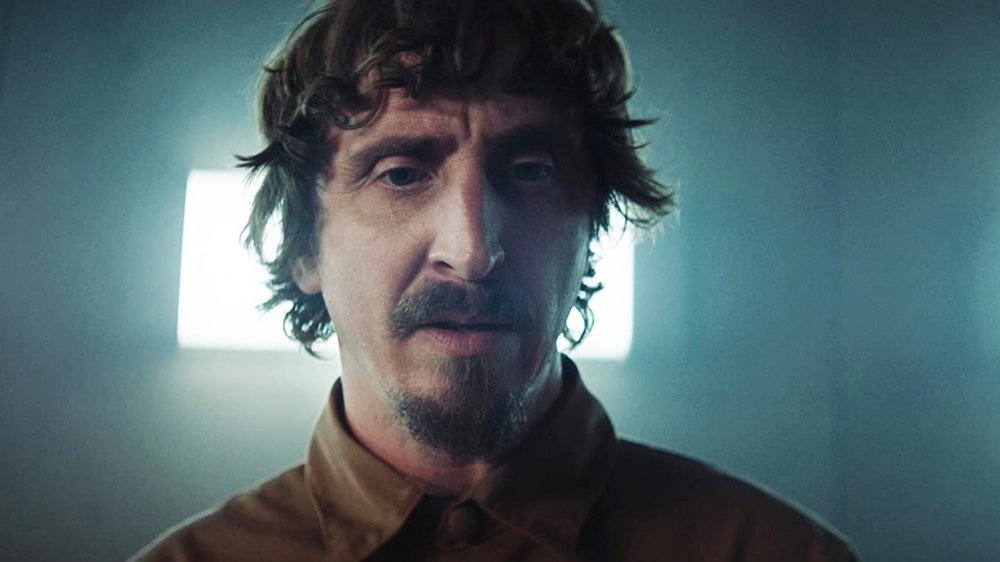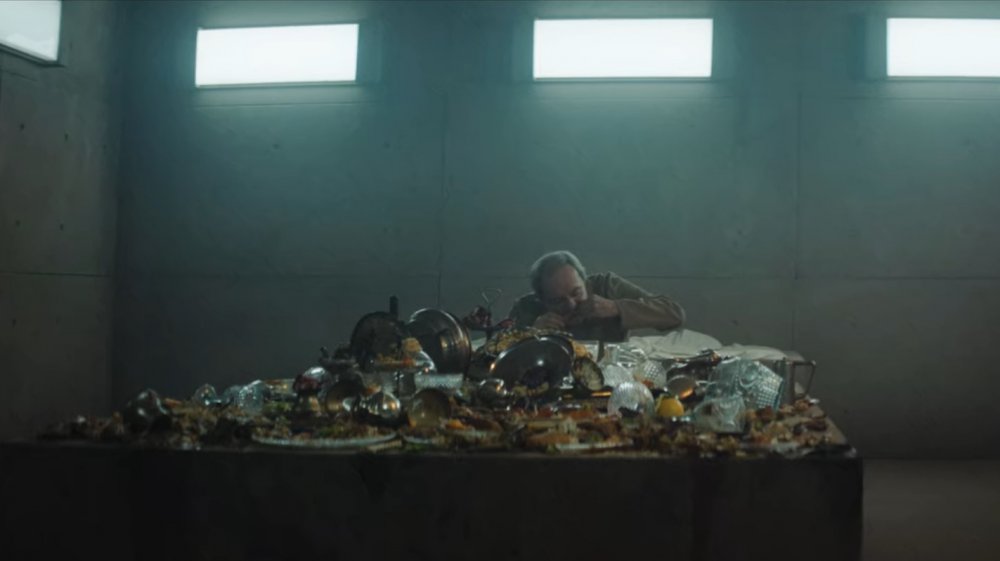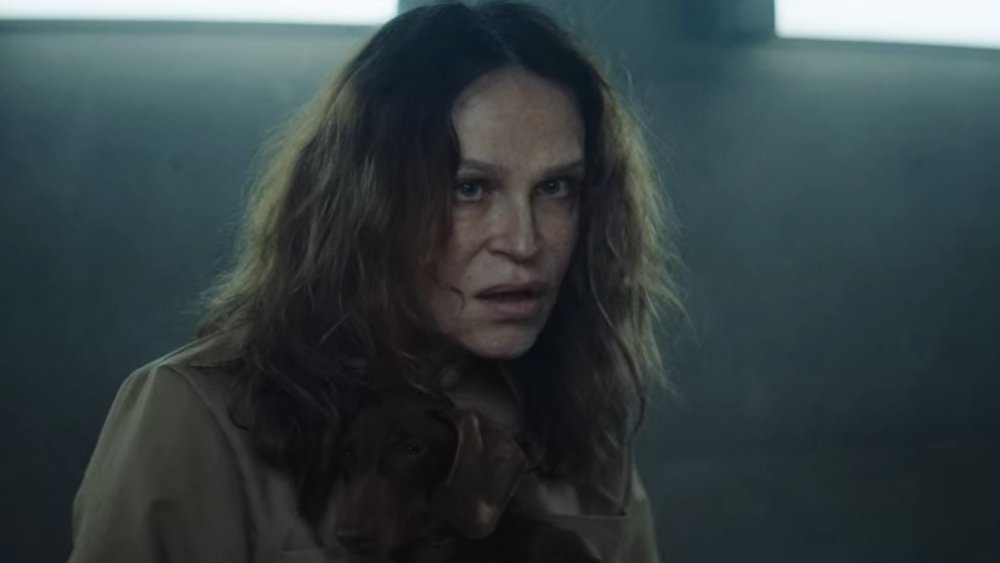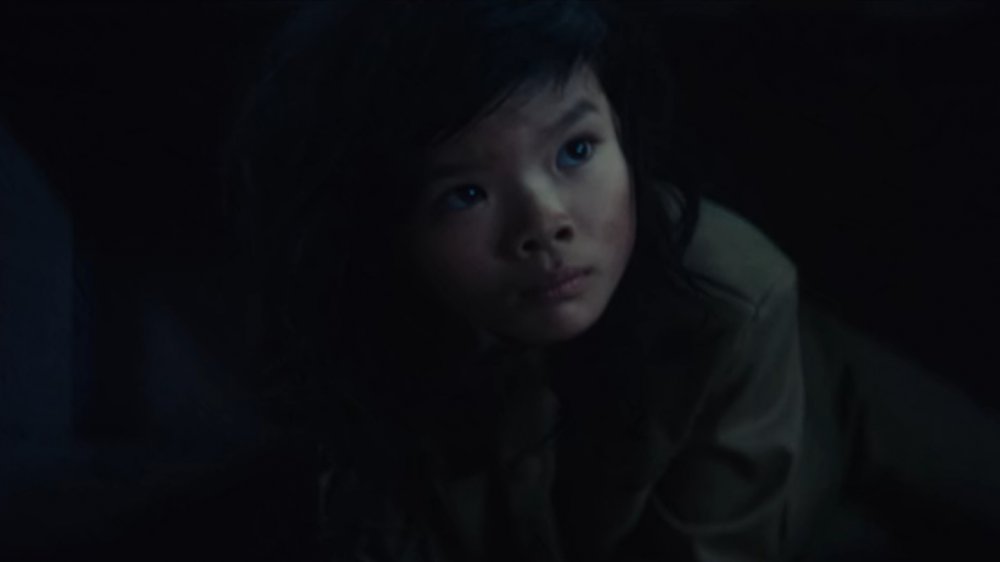The Ending Of The Platform Explained
When the Netflix original film The Platform (El hoyo in its native Spanish) dropped in February 2020, it quickly generated a ton of buzz for its unique dystopian horror setting and the prescient symbolism at the core of the narrative. At first glance, the film appears to be a story of individual greed and the struggle to survive, but as the movie reaches its haunting conclusion, it becomes clear that there's something deeper going on.
At the outset of The Platform, we're introduced to Iván Massagué's Goreng, a new inmate in a vertical prison. At the top, a team of chefs prepare a lavish feast big enough to feed everyone in the hundreds of cells below, and each day, the titular platform containing the food is lowered. The platform stops at each cell for two minutes, and the two prisoners in that cell can eat as much or as little as they want. Of course, those at the top get their fill, while those at the bottom are left with nothing and end up starving. The catch is that the prisoners are assigned a new cell each month, rearranging the pecking order in relation to the platform.
The ambiguous ending of The Platform and the film's metaphorical nature throughout have left many viewers trying to figure out what it all means. Let's run through the symbolism of the movie and what message the filmmakers wanted us to take away from the final moments. Be warned: spoilers are ahead.
What exactly is the purpose of the prison in The Platform?
We get bits of details about what the purpose of the prison is throughout, but it's not until Goreng meets Imoguiri (Antonia San Juan), who worked for the prison herself before becoming an inmate, that we get a more concrete idea.
Imoguiri tells Goreng that the administration prefers to refer to the pit-like prison as a Vertical Self-Management Center (VSC). She explains that in order for the food to reach all the way down to the lowest levels there needs to be a "spontaneous sense of solidarity" — meaning everyone, without communicating to one another, only takes as much as they need. She seems to imply that the whole purpose of the prison is to create a system in which people can learn to foster this spontaneous sense of solidarity.
However, Goreng proposes a more sinister interpretation: "If that solidarity emerged, they'd know to prevent it happening on the outside." If we are to take Goreng's interpretation of the prison, then it's a small-scale model of a harsh capitalist system that the ruling class is using to test the responses of the proletariat. It's a tool for the rulers, not society as a whole.
What do each of the characters in The Platform represent?
Most of the main characters we meet in The Platform represent archetypes or ideas larger than themselves. For instance, Goreng, who volunteers to enter the pit in order to obtain a college diploma, represents an idealist intellectual. At the beginning of the film, he shames the greed of those who take more than their share when they have the opportunity, but doesn't understand why they do it, as he has yet to spend a month at the bottom of the pit.
Similarly, Imoguiri represents the willfully ignorant bureaucrats upon which a system like the VSC rely in order to function. When Imoguiri enters the pit, it's revealed that she's mostly in the dark as to what actually happens in there. Like Goreng, she attempts to convince the prisoners below her to ration their food, but they don't listen to her pleas.
Perhaps the most enigmatic character in The Platform is Miharu (Alexandra Masangkay), a mute woman who rides the platform each month in search of her young child. Miharu is disdained by the fellow prisoners and is often attacked. Even Imoguiri derides her struggle, claiming that her search for her child is a lie because nobody under 16 is allowed in the pit. Miharu represents those who suffer on the periphery of society, whose stories we don't want to believe because they sound so cruel that we can't imagine that we live in the same system — for instance, people experiencing homelessness or other forms of extreme poverty.
The meaning behind the the ending of The Platform
At the end of the film, we learn that Miharu's child is real, and has been living at the very bottom of the pit. Goreng arrives there after riding the platform down with a weapon, enforcing the rationing of the food by beating and killing anyone who tries to take more than their share. His plan is to return back to the top level with an uneaten dessert, a symbol that the prisoners have learned how to work together to survive in such a way.
However, after finding the child, Goreng realizes that that isn't the message he needs to send. The discovery of Miharu's child is confirmation of the most important component of the VSC experiment: those in power set the rules, but they clearly don't follow them themselves. Although they've assured everyone they would never do something as cruel as allow a child into such a horrendous existence, that was a lie.
The conclusion of The Platform sees Goreng sending the child back up on the platform as a message to the chefs at the top, who are presumably in a similar state of ignorance as Imoguiri. Instead of proving to them that the prisoners can adapt to the system, he wants to show them that the system itself is unspeakably and unfathomably cruel, and those operating it cannot be trusted.
The Platform director Galder Gaztelu-Urrutia explains the film's ending
While digging into the meaning of a film's ending on one's own is worthwhile to unravel what went down, nothing quite compares to hearing what the movie's director has to say about it all. Luckily, The Platform director Galder Gaztelu-Urrutia spoke with Digital Spy in September 2019 following the film's world premiere, and shed some light on the ambiguous ending.
For Gaztelu-Urrutia, who directed from a script written by David Desola and Pedro Rivero, the way The Platform wraps up demonstrates "the failings of different ideologies." Additionally, while The Platform does offer a critique on capitalism at the outset, as it progresses, its focus and its message shifts.
"We certainly do think that there has to be a better distribution of wealth, but the film is not strictly about capitalism," explained Gaztelu-Urrutia. "There may be a criticism of capitalism from the beginning, but we do show that as soon as Goreng and Baharat try out socialism to convince the other prisoners to willingly share their food, they end up killing half of the people they set out to help."
He continued, "In the end, the problem arises when you try to demand everyone's collaboration, and you see that there is no big achievement by the end. Goreng does what he set out to do in bringing the panna cotta and the child down to the lowest level, but he didn't change anyone's mind about sharing the food [...] To me, that lowest level doesn't exist. Goreng is dead before he arrives, and that's just his interpretation of what he felt he had to do."
In the end, Gaztelu-Urrutia aimed for The Platform's conclusion to be "open to interpretation, whether the plan worked and the higher-ups even care about the people in the pit." An alternate ending of was even filmed, though it was obviously scrapped in favor of the one viewers saw. "We actually did film a different ending of the girl arriving at the first level, but we took it out of the movie," said Gaztelu-Urrutia. "I'll leave what happens to your imagination."




